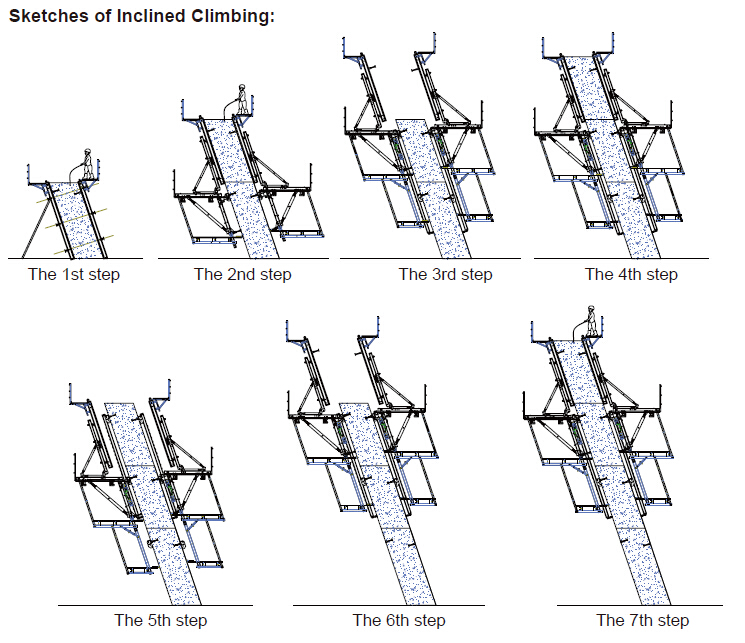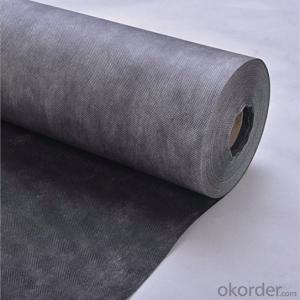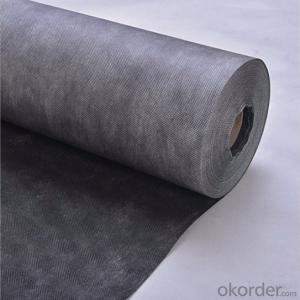Auto Climbing Bracket ACB-100 & ACB-50 for formwork and scaffolding system
- Loading Port:
- Tianjin
- Payment Terms:
- TT OR LC
- Min Order Qty:
- 50 m²
- Supply Capability:
- 1000 m²/month
OKorder Service Pledge
OKorder Financial Service
You Might Also Like
Auto-climbing Bracket ACB100 & ACB50
The power of the auto-climbing formwork is the hydraulic system, which includes the oil cylinder
and two commutators. The commutators can control the climbing of climbing rail and the bracket.
The steel rail and the bracket can inter-climbing, so the whole system will climb up steadily.
Cranes are not needed during the construction. It’s easy to operate, highly efficient and safe. It’s
the best choice for the construction of high buildings and bridges.
There are mainly two types of standard auto-climbing brackets, ACB-50 and ACB-100, the figure
means the push power of cylinder with unit of KN.
Characteristics:
◆ Perfect load bearing anchor system
Anchor system is the most important supporting part. The system is made of five parts shown
below. Thereinto, tensile bolt, V-climbing cone and washer can be taken out for reusing after the
concrete pouring finished.There are two kinds of anchor systems,A & B. A is matched with single
anchor shoe and B is matched with double anchor shoe.
◆ Crane-independent
Crane-independent forming, striking and climbing speeds up the work procedures on the
construction site and also makes them independent of each other. This means the planned
sequences can be maintained along with guaranteeing high productivity levels. The crane can
therefore be used for other tasks.
Hydraulic system is mainly made of two commutators,
oil cylinder and power distribution system.The
commutators can control the climbing of climbing rail
and bracket.
◆ High bearing capacity and safe
The stable working platforms are able to carry large loads, e.g. the storage of reinforcing steel
for the next climbing section. Generously-sized working platforms, the well thought-out design for
handling very high wind loads and the patented control function of the climbing mechanism are
some of the special details contained within the comprehensive safety concept.
◆ Platforms adjusted to suit the angle of inclination
The horizontal working areas thus created provide safe and comfortable conditions for
reinforcement work, shuttering and striking, concreting and finishing.
◆ The ACB formwork system can climb not only vertically but also slantways, the largest angle is
18 degrees.
◆ The system can climb up wholly or separately. The climbing process is steady, synchronous
and safe.
◆ The bracket will not fall to the ground until the construction is finished, the field will be saved
and the impacting breakage will be reduced (especially the panel).
◆ The system will furnish omnidirectional platform, the construction organizations don’t need to
set up additional operation platform.
◆ The error of structure construction is small and easy to correct.
◆ The climbing speed is fast, the construction course will be quickened.
◆ The formwork can climb itself and cleaning work can be done in the same situs , the used times
of tower crane will be greatly reduced.

- Q:Can steel formwork be used for complex geometric shapes?
- Yes, steel formwork can be used for complex geometric shapes. Steel is a versatile and durable material that can be easily manipulated to create intricate and unique formwork designs. Its strength allows for the construction of complex shapes without compromising structural integrity, making it suitable for various architectural and construction applications.
- Q:Can steel formwork be used for structures with high thermal insulation requirements?
- No, steel formwork is not typically used for structures with high thermal insulation requirements.
- Q:What are the safety precautions when using steel formwork?
- To ensure the well-being of workers and the successful completion of the project, it is important to adhere to several safety precautions when using steel formwork. These precautions include: 1. Adequate training and awareness: Proper training should be provided to all workers involved in the use of steel formwork. They should be knowledgeable about potential hazards and the correct procedures to follow. 2. Inspection and maintenance: Thoroughly inspect the steel formwork before use to identify any defects or damage. Any weakened or damaged parts should be repaired or replaced. Regular maintenance should also be carried out to keep the formwork in good condition. 3. Proper handling and storage: Due to the weight of steel formwork, appropriate lifting and handling equipment, such as cranes or forklifts, should be used to avoid strain or injuries. When storing the formwork, ensure it is securely fastened to prevent accidents. 4. Fall protection: Implement fall protection measures, such as guardrails, safety nets, or personal fall arrest systems, when working at heights with steel formwork. Workers should be provided with safety harnesses and trained in their use. 5. Secure installation: Ensure the steel formwork is securely installed to prevent collapse or movement during concrete pouring or other construction activities. Follow the manufacturer's instructions and use appropriate bracing and support systems for stability. 6. Adequate signage and barriers: Place proper signage and barriers around the work area to warn others of potential hazards and restrict access to authorized personnel only. This helps prevent accidents and keeps unauthorized individuals away from the site. 7. Personal protective equipment (PPE): All workers using steel formwork should wear appropriate PPE, including hard hats, safety boots, gloves, and eye protection. This protects them from injuries caused by falling objects or sharp edges. 8. Regular communication and coordination: Maintain effective communication and coordination among workers using steel formwork to ensure a safe working environment. Provide clear instructions, hold regular safety meetings, and have emergency procedures in place to keep everyone aware of their roles and responsibilities. By following these safety precautions, the risks associated with using steel formwork can be minimized, and a safe working environment can be maintained for all construction project workers.
- Q:How does steel formwork handle concrete temperature differentials?
- Steel formwork is a popular choice for concrete construction due to its durability and strength. When it comes to handling concrete temperature differentials, steel formwork offers several advantages. Firstly, steel has a high coefficient of thermal conductivity, meaning it can quickly absorb and distribute heat. This property allows steel formwork to efficiently dissipate the heat generated during the hydration process of concrete. As a result, steel formwork helps to minimize the risk of thermal cracking caused by temperature differentials. Furthermore, steel formwork is known for its dimensional stability. Unlike other materials like wood, steel does not expand or contract significantly with temperature changes. This stability ensures that the formwork maintains its shape and integrity, even when exposed to varying concrete temperatures. It helps to prevent any distortions, warping, or bulging that could affect the quality and appearance of the concrete structure. Additionally, steel formwork is resistant to fire and high temperatures, making it suitable for handling concrete that undergoes rapid temperature changes, such as in hot weather conditions or during the curing process. Its ability to withstand extreme temperatures without deforming or losing its structural integrity ensures that the formwork remains intact and provides the necessary support and containment for the concrete. In summary, steel formwork effectively handles concrete temperature differentials by efficiently dissipating heat, maintaining dimensional stability, and withstanding high temperatures. These properties contribute to the overall quality and durability of the concrete structure, while minimizing the risk of thermal cracking and other issues caused by temperature variations.
- Q:What are the common safety guidelines when working with steel formwork in hazardous areas?
- When working with steel formwork in hazardous areas, it is important to adhere to certain safety guidelines to ensure the protection of workers and prevent accidents. Here are some common safety guidelines to follow: 1. Personal Protective Equipment (PPE): All workers should wear appropriate PPE such as safety goggles, gloves, steel-toed boots, and hard hats to protect themselves from potential hazards. 2. Training and Education: Workers should receive proper training on how to work with steel formwork and be educated about the potential hazards associated with the specific hazardous areas they will be working in. This includes knowing how to handle steel formwork safely and understanding emergency procedures. 3. Hazard Identification and Risk Assessment: Before starting any work, a thorough assessment of the hazardous area should be conducted to identify potential risks and hazards. This will help in implementing appropriate safety measures and controls. 4. Fall Protection: If working at heights, proper fall protection measures should be in place, such as guardrails, safety harnesses, and safety nets. Workers should be trained on the correct use of fall protection equipment and systems. 5. Fire Safety: In hazardous areas, there may be an increased risk of fire. Ensure that fire extinguishers are readily available, workers are trained in their use, and emergency evacuation plans are in place. 6. Electrical Safety: Any electrical equipment or tools used in the vicinity of the steel formwork should be properly grounded and regularly inspected for safety. Workers should be cautious and avoid contact with live wires. 7. Proper Handling and Storage: When working with steel formwork, it is crucial to handle and store the materials properly to prevent injuries. This includes using appropriate lifting equipment, securing the formwork properly, and storing it in designated areas to avoid tripping hazards. 8. Adequate Ventilation: If working in confined spaces, ensure proper ventilation is in place to prevent the buildup of toxic gases or fumes. Workers should be trained on the signs and symptoms of exposure to hazardous substances. 9. Regular Inspections and Maintenance: Regular inspections of the steel formwork and surrounding areas should be conducted to identify any potential safety hazards. Any necessary repairs or maintenance should be carried out promptly. 10. Communication and Emergency Procedures: Clear communication should be established between workers, supervisors, and other stakeholders to ensure everyone is aware of the potential hazards and emergency procedures. Regular safety meetings and drills can help reinforce this communication. By following these common safety guidelines, workers can minimize the risks associated with working with steel formwork in hazardous areas and create a safer working environment.
- Q:What are the considerations when designing steel formwork for culverts?
- When designing steel formwork for culverts, several considerations need to be taken into account. Firstly, the formwork must be strong and durable enough to withstand the pressures exerted by the concrete during the pouring and curing process. It should be able to support the weight of the concrete without warping or collapsing. Additionally, the formwork should be designed to allow for proper drainage and prevent the occurrence of any water accumulation or pockets within the culvert. Adequate provision for weep holes and outlets should be made to ensure smooth water flow. The geometry and dimensions of the culvert must be carefully considered when designing the formwork. It should be designed to accurately shape the culvert, ensuring that it conforms to the desired size and shape specifications. This may involve the use of adjustable panels or modular systems to accommodate different culvert sizes and configurations. Another important consideration is ease of assembly and disassembly. The formwork should be designed in a way that allows for quick and efficient installation and removal. This can help save time and labor costs during construction. Lastly, safety is a crucial consideration when designing steel formwork for culverts. Adequate precautions should be taken to ensure the stability of the formwork during construction, preventing any accidents or injuries. This may involve incorporating proper bracing, anchoring, and support systems to maintain the integrity of the formwork structure. Overall, the considerations when designing steel formwork for culverts include strength, drainage, geometry, ease of assembly, and safety. By addressing these factors, a well-designed formwork system can facilitate the construction of durable and functional culverts.
- Q:How does steel formwork handle concrete surface finishing?
- Steel formwork is known for its durability and strength, making it highly effective in handling concrete surface finishing. It provides a smooth and even surface, allowing for precise and accurate finishing techniques such as troweling or polishing. Additionally, steel formwork minimizes the risk of surface imperfections and ensures consistent results throughout the entire concrete structure. Its robustness also enables multiple reuses, reducing construction costs and enhancing overall efficiency.
- Q:Can steel formwork be used for different types of concrete finishes?
- Yes, steel formwork can be used for different types of concrete finishes. Steel formwork is highly versatile and can be customized to create various concrete finishes such as smooth, textured, or patterned surfaces. The steel formwork allows for precise shaping and molding of the concrete, enabling the creation of different finishes according to the desired design and aesthetic requirements. Additionally, steel formwork can be easily adjusted and reused for different projects, making it a cost-effective choice for achieving diverse concrete finishes.
- Q:Can steel formwork be used for both regular and irregular concrete structures?
- Yes, steel formwork can be used for both regular and irregular concrete structures. Steel formwork is highly versatile and can be easily customized to fit any shape or size of the structure. This makes it suitable for constructing both regular structures with standard dimensions as well as irregular structures with unique shapes and designs. The flexibility of steel formwork allows for efficient construction of various types of concrete structures, including walls, columns, beams, slabs, and even complex architectural features. Additionally, steel formwork offers high strength and durability, ensuring that it can withstand the pressure and weight of the concrete during the pouring and curing process, regardless of the structure's regular or irregular shape. Overall, steel formwork is a reliable and adaptable choice for constructing both regular and irregular concrete structures.
- Q:What are the typical lead times for manufacturing and delivering steel formwork?
- The typical lead times for manufacturing and delivering steel formwork can vary depending on various factors. Generally, lead times can range from a few weeks to a few months. The manufacturing lead time for steel formwork typically depends on the complexity of the design, the quantity required, and the capacity of the manufacturer. If the design is straightforward and the manufacturer has available capacity, the lead time can be relatively shorter, around 2-4 weeks. However, if the design is more intricate or if the manufacturer is facing high demand or limited capacity, the lead time can extend to 6-8 weeks or even longer. Once the steel formwork is manufactured, the delivery lead time will depend on the distance between the manufacturing facility and the project site, as well as the mode of transportation chosen. Local or regional deliveries can generally be completed within a few days to a week, whereas international shipments may take longer due to customs clearance and additional logistics involved. It is important to consider these factors when estimating the overall lead time for steel formwork delivery. It is worth noting that these lead times are just general estimates, and actual lead times can vary significantly depending on the specific circumstances. Therefore, it is recommended to consult with the manufacturer or supplier directly to get accurate lead time information for a particular steel formwork project.
1. Manufacturer Overview |
|
|---|---|
| Location | |
| Year Established | |
| Annual Output Value | |
| Main Markets | |
| Company Certifications | |
2. Manufacturer Certificates |
|
|---|---|
| a) Certification Name | |
| Range | |
| Reference | |
| Validity Period | |
3. Manufacturer Capability |
|
|---|---|
| a)Trade Capacity | |
| Nearest Port | |
| Export Percentage | |
| No.of Employees in Trade Department | |
| Language Spoken: | |
| b)Factory Information | |
| Factory Size: | |
| No. of Production Lines | |
| Contract Manufacturing | |
| Product Price Range | |
Send your message to us
Auto Climbing Bracket ACB-100 & ACB-50 for formwork and scaffolding system
- Loading Port:
- Tianjin
- Payment Terms:
- TT OR LC
- Min Order Qty:
- 50 m²
- Supply Capability:
- 1000 m²/month
OKorder Service Pledge
OKorder Financial Service
Similar products
New products
Hot products
Hot Searches

























